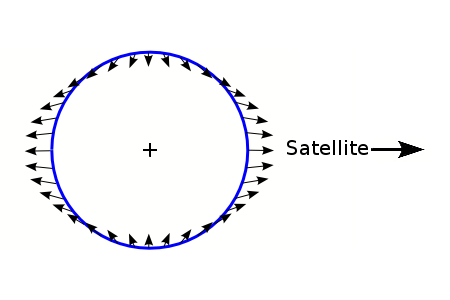Hey errybody! How've you been? Good, good.
Did you know the Moon is squeezing the Earth? It is indeedy. The Earth's generally pretty solid, so it can be hard to notice. Water however, is not quite so solid. Lucky us! The world would surely be less interesting without tides.
Up there is a schematic of the effects of a strong central gravitational force some distance away. For us, it causes tides, mostly due to the Moon, with about half as strong of an effect from the Sun. Heck, its even doing it to your mushy, watery body, just not with any strength we're capable of detecting (nor are we wide enough). (Fun Fact: these are the same forces that cause the popular "spaghettification effect" when falling into a black hole)
So what? Sew buttons! Because something like the LHC, about 3 miles wide, is indeed big enough to feel these effects. I'll let the shift leader at the time explain:
Data was coming in at a high rate and all sub-detectors were humming nicely. Not a glitch in hours so we were getting slightly sleepy nearing the end of the shift around 22:00. So when a colleague from the trigger system (the system that decides which events are worth keeping) called to inquire about recurrent splashes of data, I was rather puzzled.
I quickly went around, asking a few shifters to check their system. Nobody had a clue. Then I took a closer look at this plot that I had not scrutinized before since everything was so seamless.
What she was perturbed by were those dips in the lower two curves, which measure the intensity of the collisions.
So I called the LHC control room to find out what was happening. “Oh, those dips?”, casually answered the operator on shift. “That’s because the moon is nearly full and I periodically have to adjust the proton beam orbits.”Humans are amazing.
This effect has been known since the LEP days, the Large Electron Positron collider, the LHC predecessor. The LHC reuses the same circular tunnel as LEP. Twenty some years ago, it then came as a surprise that, given the 27 km circumference of the accelerator, the gravitational force exerted by the moon on one side is not the same as the one felt at the opposite side, creating a small distortion of the tunnel. Since the moon’s effect is very small, only large bodies like oceans feel its effect in the form of tides. But the LHC is such a sensitive apparatus, it can detect the minute deformations created by the small differences in the gravitational force across its diameter. The effect is of course largest when the moon is full.
Enjoy your weekend!


No comments:
Post a Comment